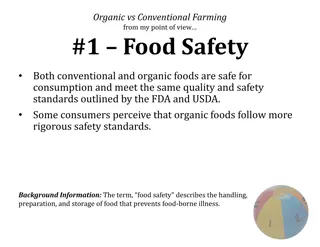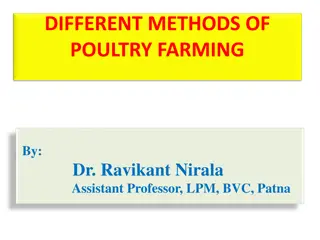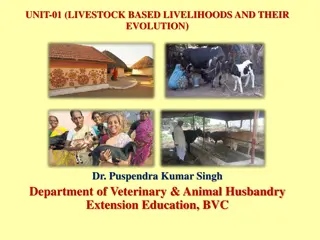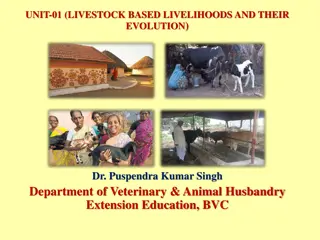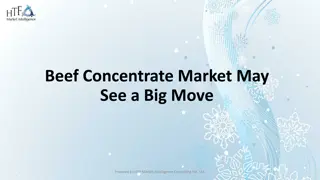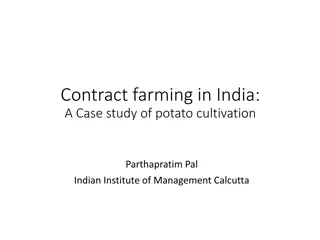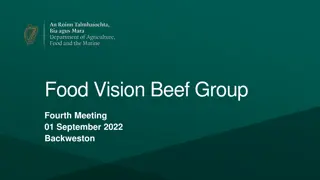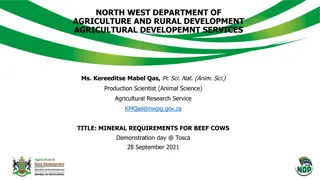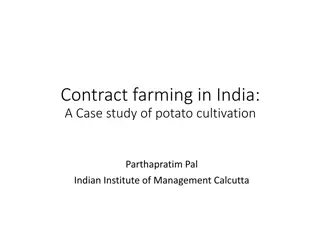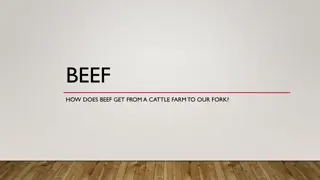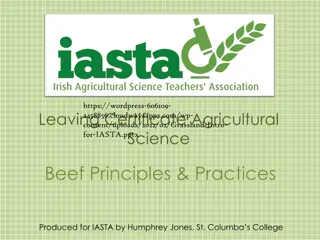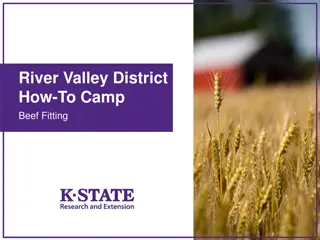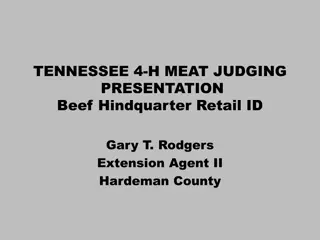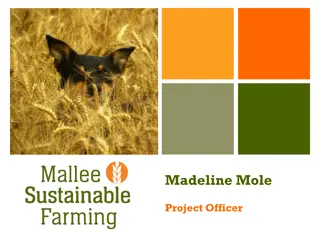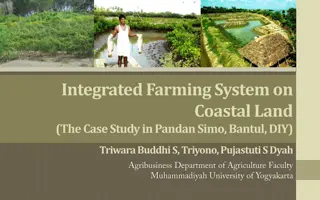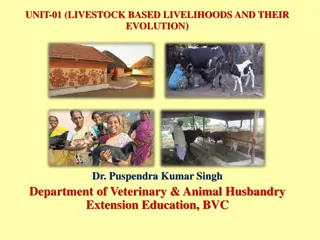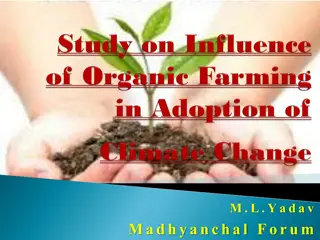Co-definition and Evaluation of Sustainable Beef Farming Systems
This project aims to address the reduced sustainability of beef farming systems in the EU by developing innovative ways to improve production using non-edible resources. It focuses on overcoming challenges such as feed competition, market developments, and environmental impact to enhance the resilience and competitiveness of European animal production.
Download Presentation

Please find below an Image/Link to download the presentation.
The content on the website is provided AS IS for your information and personal use only. It may not be sold, licensed, or shared on other websites without obtaining consent from the author.If you encounter any issues during the download, it is possible that the publisher has removed the file from their server.
You are allowed to download the files provided on this website for personal or commercial use, subject to the condition that they are used lawfully. All files are the property of their respective owners.
The content on the website is provided AS IS for your information and personal use only. It may not be sold, licensed, or shared on other websites without obtaining consent from the author.
E N D
Presentation Transcript
SUSTAINBEEF SUSTAINBEEF Co-definition and evaluation of SUSTAINable BEEF farming systems based on resources non edible by humans Sylvain Hennart Mid-term COFUNDED Projects Seminar 10-11 April 2019, Wageningen (Netherlands) The ERA-net Cofund SusAn is funded by European Union s Horizon 2020 Research and Innovation programme under grant agreement n 696231
Index Index Objective : Objective : presented and discussed various projects and associated problems and solutions: presented and discussed various projects and associated problems and solutions: Learning processes involved in scientific and technical development which covered projects. Learning processes involved in scientific and technical development which covered projects. 0. Project description and Preliminary results (information summarized from the poster) 1. Contribution to SusAn research objectives : Research and innovation on sustainable animal production co-funded in ERA-NET SusAn should address a number of high-level objectives, towards the development of Sustainable Animal Production systems in Europe 2. Research Impact on the 3 pillars of sustainability: Area 1 ( Economy ): Improve the productivity, resilience and competitiveness of European Animal Production Area 2 ( Environment ): Improve and manage resource use to reduce waste and enhance the environmental sustainability of European animal production Area 3 ( Society ): Improve on-farm practices to enhance consumer acceptability and address societal challenges associated with animal welfare, product quality and safety, biodiversity and provision of ecosystem services 3. Transnational collaboration and will facilitate knowledge exchange, sharing of good practice and will transfer knowledge to practice through connections with important stakeholders in the animal production chain 4. Multi actor approach which will encourage input and draw effort from across the European scientific and technical communities, at the fundamental, strategic and applied levels to ensure involvement and participation from all relevant stakeholders along the whole value added chain 5. Cross-scale approach is an approach which takes into account the differences between scales with their specific properties e.g. farm, regional, national, European and global scale. It is expected that interactions between the levels is integrated in the development of innovations. 6. Dissemination and communication strategy Dissemination of results will contribute to exploitation by transforming knowledge produced in the research projects funded by the ERA-NET SusAn co-funded call and subsequent call(s) into solutions to current challenges for a sustainable European animal production.
Project Project description description Problems addressed in the project Reduced sustainability of beef farming systems in the EU due to increased use of concentrate feeds abandonment of grassland based systems market developments decrease of red meat demand dependency on direct support to beef production Controversy about animal productions Environmental impact Feed/food competition Objectives Develop and assess innovative ways to improve the sustainability of beef production systems by valorizing resources non-edible by humans
Preliminary Preliminary results results Selection and description of 20 innovations decreasing feed-food competition 13 farm-case studies France Belgium Italy Germany 42 indicators of sustainability according to fuzzy logic Environmental Social Economic
Contribution to SusAn research objectives Contribution to SusAn research objectives : : Which is the contribution of your research to SusAn objectives research to SusAn objectives Which is the contribution of your To improve the competitiveness and resilience of the entire beef value chain All actors of the value chain contribute to the innovations catalogue and to validation of scenarios Use of natural and non- or poorly renewable resources efficiently A better valorisation of permanent grassland and coproduct will decrease the use of resources edible by human (work hypothesis)
Contribution to SusAn research objectives Contribution to SusAn research objectives : : Which is the contribution of your research to SusAn objectives research to SusAn objectives Which is the contribution of your To make more efficient utilisation of feed, taking into account land use and quality to achieve an optimum balance between food and feed production The aim of this project is to identify innovations reducing the feed-food competition (including a better use of grassland and pasture) and to evaluate the impact of their implementation on beef production sustainability To consider opportunities for converting non-edible feedstuffs into valuable human edible protein sources and other animal products main objective of SUSTAINBEEF in beef production sector
Research Impact on the 3 pillars of sustainability: Research Impact on the 3 pillars of sustainability: Does the project adequately address the different pillars? How do the different pillars adequately address the different pillars? How do the different pillars contribute to the aim of your project? contribute to the aim of your project? Does the project The three pillars are approached across two ways: In FarmDyn the evaluation of each sustainability pillars is taken into account : Economic: the model optimizes the net profit of the farm Environmental: GHG emissions, N balance Social: work load Sustainability evaluation tree also considers the three pillars : Economy: Income, Efficiency and Farm capacity to cope with risk Environmental: Atmosphere, Water, Resource and energy, and Biodiversity Social: food safety, animal welfare, working load, territorial employment and transmissibility
Research Impact on the 3 pillars of sustainability: Research Impact on the 3 pillars of sustainability: How relevant are the links made between the pillars? made between the pillars? How relevant are the links Key assumption: Economical survival is required for any sustainability improvement and has a strong influence on farm decisions profit / utility optimization considering (dis)incentives by policy instruments (coupled support, greening obligations, nitrates directive, agri-environmental programs) Impact on others pillars quantified based on optimized farm program, using indicator framework Innovations can be forced in to quantify their contribution and the necessary economic incentives for their realization
Transnational collaboration: Transnational collaboration: What is the added value of transnational What is the added value of transnational collaboration? collaboration? Association and exchange of knowledge and competence German team focuses on bio-economic modeling with FarmDyn French team develops evaluation tree of sustainability and case studies description Belgium provides expertise in qualitative data analysis methodology and multi-actors approaches All partners present production systems different in organization, resource use, intensification giving the opportunity to evaluate innovations from different perspectives Results address a broad diversity of beef production system across Europe Evaluation will be done with the same harmonized methodology
Transnational collaboration: Transnational collaboration: Is the transnational collaboration beneficial for Is the transnational collaboration beneficial for broad implementation of the results? broad implementation of the results? During the focus group, all innovations (i.e. innovations of each region) were presented and discussed with participants of each region : Farmers Farm Advisers Up and downstream actors of the value chain On this basis we expect a broad diffusion and implementation of the outcomes of the project
Multi actor approach Multi actor approach: Is there a strategy to involve relevant stakeholders? : Is there a strategy to involve relevant stakeholders? What we did : Use data and mobilize farm advisors and experts to identify relevant farmers profiles to involve and involve relay actors to recruit them Identify and mobilize representative actors per each activity within the value chain Invite all the stakeholders on a voluntary basis Ensure the follow-up of issues raised in focus groups What we will do : Invite all participants involved in interviews and focus groups to validate scenarios Organize one transnational focus group to present and assess results related to decreasing feed-food competition in beef production
Multi actor approach Multi actor approach: Are research outcomes validated under practical : Are research outcomes validated under practical conditions along the whole value added chain? conditions along the whole value added chain? Identified innovations submitted to Farmers & advisers : identify levers and barriers at farm scale Up- and downstream value chain actors: identify levers and barriers at value chain scale Later validation of scenarios with all actors mobilized for focus groups plus individual interviews Stakeholders (i.e.: farmers, farm advisers, up and downstream value chain actors) Experts (i.e. scientists, thematic advisers)
Cross Cross- -scale approach: scale approach: In how far does it make sense in the particular In how far does it make sense in the particular research project to target the different levels? How relevant are the research project to target the different levels? How relevant are the interactions seen between the levels? interactions seen between the levels? The project will consider all the value chain : Typical barriers to implement innovations at farm level concern the market or a link of the value chain Importance to have point of view of all members of the value chain Pointed out by farmers Innovation s implementation depending of the opportunity to valorize the produces (new feeds, by-products, meat ) within the value chain
Cross Cross- -scale approach: scale approach: Which is the Impact of the project in terms of Which is the Impact of the project in terms of knowledge acquisition? knowledge acquisition? Farmers: propose new innovations along with quantified pros/cons for case studies Value chain actors : communicate potentially interesting farm-scale innovations to support, e.g. by developing labels Regional to European legislator: communicate potentially interesting farm-scale innovations to support along with contributions to three pillars of sustainability
Dissemination and communication strategy: I Dissemination and communication strategy: Is there strategy for exploiting the potential of the projects results? the potential of the projects results? s there strategy for exploiting The strategy of publication is under development 4 scientific articles are planed Each partner has to publish at least 2 technical publications or publications targeting a wider public Scenarios will be discussed in focus groups with stakeholders (i.e. farmers, farm advisers, value chain actors) Results will be disseminated to farmers through advising associations : AWE (Be), regional agricultural rooms (Fr),
Dissemination and communication strategy: Dissemination and communication strategy: Do you disseminate the projects results via Open Data? results via Open Data? Do you disseminate the projects Publication in open access journals or negotiation with publishers to enable immediate open access or delayed open access of up to 6 months as requested Development of an open data repository to store the data generated by the project, together with the associated metadata




